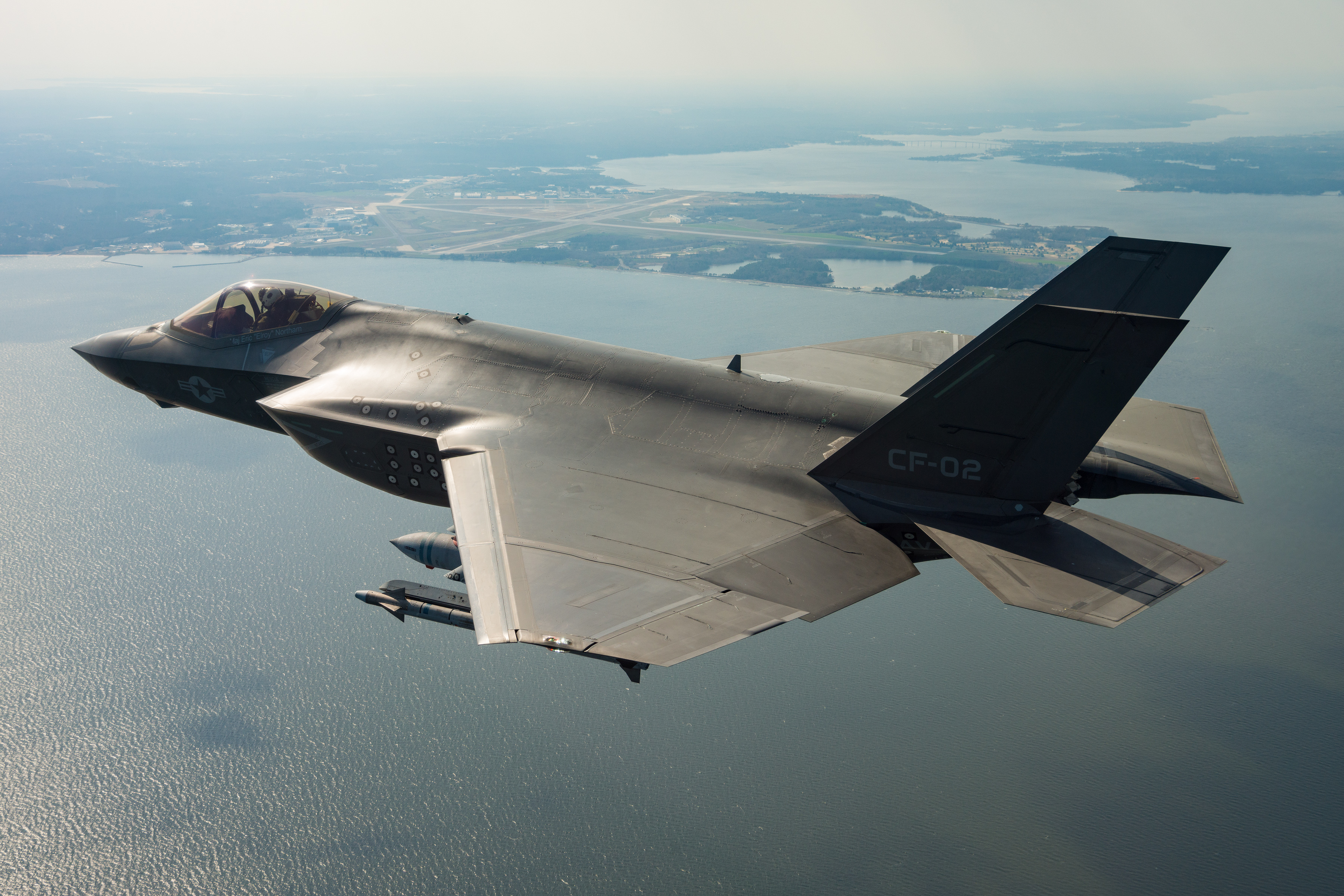
This F-35C completed a test mission to collect loads data while carrying external 2,000-pound GBU-31 Joint Direct Attack Munitions (JDAM) and AIM-9X Sidewinder heat-seeking missiles April 11, 2018. Photo courtesy of Lockheed Martin.
The Pentagon’s research and engineering chief, Mike Griffin, is developing a hypersonics roadmap, to be delivered in time for the next five-year plan, that will consolidate some prototyping and research efforts now underway among the Air Force, Navy, Army, DARPA, and other defense agencies.
Griffin’s initiative was revealed by Deputy Defense Secretary Patrick Shanahan, during a meeting Tuesday with defense reporters in Washington, D.C.
Shanahan also offered a ringing endorsement of the F-35, saying it is a “great airplane” and arguments over the fighter’s capabilities miss the point: there’s no question the aircraft itself is extraordinary, the issue is one of execution.
“Overlap of the technical challenges is pretty high,” Shanahan said of the various service and agency approaches to hypersonics. Where they really differ, he said, is in whether they are aimed at air, sea, or air-launched systems as the end product, “but [in] the basic physics portion” of the hypersonic vehicle itself, “a number of the technical building blacks are common.” Griffin’s role, Shanahan said, will be to “get synergy across the department” among the various prototyping and research efforts, not only to save money, but to accelerate a solution.
Shanahan said that Griffin, who has publicly declared hypersonics his No. 1 priority, “gave to me last week an ‘80 percent plan’ across 10 technical domains of what tests” the Defense Department must conduct “between now and 2023 in order to achieve capability in the next decade.” The full plan—Shanahan said “roadmap” is “a fair characterization”—should be made final in July, “and the reason that’s so important is that it forms our POM ‘20 [Program Objective Memoranda] funding process.” It will be in that process “that we start to do the consolidation and do the prioritization” among the various approaches to hypersonics.
Shanahan said the prioritization plan mirrors what happens in industry. “Everyone can’t afford to develop things on their own,” he said. “The trick in the Pentagon is collaboration at the DOD level,” where the goal is to “have confidence in execution” and assure “mutual benefit” of those involved.
Asked about calls from some watchdog groups to scrap the F-35 because it suffers from technical deficiencies, Shanahan waved off the criticisms.
The F-35 is a great airplane,” Shanahan said twice. Any comments he’s made about its problems have to do not with its capabilities, but with “program execution,” and “there’s a real difference” between those two things.
“The airplane itself is a high-performing, advanced, fifth-generation fighter,” he said. But “everything that leads up to sustainment is what we” in the aerospace industry “consider ‘spring training.’” Program execution is now the key, he said, because “when you’re producing at the volumes that we’re producing now, this is the opportunity [at which] … you take cost out. Everybody knows that. You get on rate, the job goes to: take cost out, take cost out, take cost out … That’s the law. It’s like physics.”
He said the Pentagon won’t “turn the screws” on Lockheed Martin, the manufacturer of the F-35, “but we’re going to drive affordability on the program” because if the aircraft is to be affordable, sustainment and future improvements must be worked out now. “When the aircraft goes into use … it has to work all the time,” Shanahan asserted.
The three big chores with the F-35 now, he said, are “the development of Block IV, there’s the increases for production, and introducing new customers.”
In the Block IV program, he said, decisions are being made in the POM ‘20 about what changes to incorporate, and “how do those changes earn their way onto the airplane? By that I mean … they’re not ‘nice to haves.’ They really add performance and value either in capability, reliability, or taking cost out.”
He also said it’s critical to get those decisions right, because “if we’re just dropping in all kinds of changes, it undoes everything you’ve put in place.” Beyond that, “with every airplane I’ve ever been on, … when you go into operation, you find things …. the whole idea is, find ‘em, fix ‘em. … And you do that for years. Find ’em, fix ‘em…”
The issue, though, is “about risk management for program execution. It’s not about, ‘is it a high performing aircraft?” The F-35 certainly is “a high performing aircraft,” he said. “It will always get better technically, because we’ll continue to invest in it, it will always get better from an affordability standpoint because that’s the diet that we’re on, and from a reliability standpoint, we’ll always keep fixing the airplane. So it can run like a 737.” Shanahan was a Boeing executive for 30 years.
